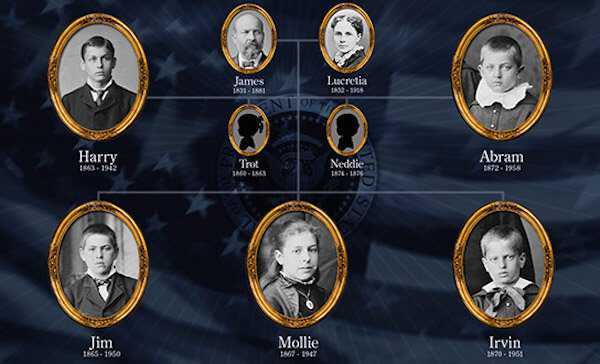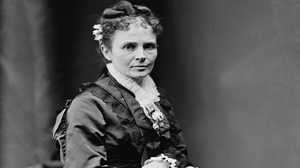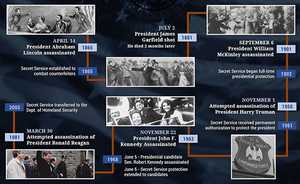The Garfield Children
James and Lucretia Garfield had seven children, five of whom survived into adulthood to make a lasting impact on their country. The passing of the Garfield's first and last children at ages three and one, respectively, brought tragedy to the family that affected both James and Lucretia deeply. But James Garfield, before being elected president, had a busy political career that often kept him from home. "It is a pity," he once wrote, "That I have so little time to devote to my children." So, when the family moved to the White House after Garfield's 1881 inauguration, Garfield saw it as a blessing; no matter how daunting his workload, his family was always nearby. Unfortunately, this familial bliss would only last for a short time as Garfield was shot by a deranged office-seeker just four months into his presidency. Despite their father's untimely death, Garfield's five surviving children would go on to achieve great things in both their public and private lives, carrying on the legacy of their accomplished father.

On July 2, 1881, President James Garfield and his two eldest sons, 17-year-old Harry and 16-year-old Jim, were at the Baltimore and Potomac Railway Station in Washington, D.C. where they would travel to President Garfield's class reunion at Williams College in Massachusetts. They would never even board the train. On entering the station, President Garfield was shot in the back by Charles Guiteau; he would die two months later on September 19, just two weeks after Harry and Jim started classes at their father's alma mater.
After graduating from Williams College in 1885, Harry "Hal" Garfield would study law at Columbia University, eventually returning to his home state of Ohio to establish a law practice with his brother Jim. In 1903, Harry became a professor of politics at Princeton University, where he befriended future U.S. president Woodrow Wilson -- who was, at the time, president of Princeton. In 1908, Harry was inducted as the eighth president of his, and his father's, alma mater, Williams College. In 1917, Harry took a leave of absence from Williams when he was appointed by President Wilson to serve as fuel administrator for the newly-created U.S. Fuel Administration during WWI. In that capacity, Harry would negotiate with coal mine owners and the United Mine Workers union to set a fair wartime price for coal -- pleasing the mine owners while also establishing better wages for mine workers. The contentious relationship between the UMWA and the mine owners brought other controversies and disagreements with it, but Harry was able to navigate the choppy waters with some success.
Harry Garfield was not the only member of the Garfield family to enter into politics. His brother, Jim was an esteemed advisor to President Theodore Roosevelt. After a year serving on the U.S. Civil Service Commission, Jim became commissioner of corporations in Roosevelt's newly-created Department of Commerce & Labor from 1903-1907. As commissioner, Jim investigated large corporations in the meat-packing, steel and railroad industries among others. In 1907, Jim was appointed Secretary of the Interior where he oversaw the conservation of America's natural resources. "He has such poise and sanity," Roosevelt would write of Jim, "he is so fearless, and yet possesses such common sense, that he is a real support to me."
James and Lucretia's two younger surviving sons, Irvin and Abe, were once renowned for their boisterous escapades during their father's presidency. In fact, Irvin was known as the "terror of the White House" for riding his bicycle around the halls of the executive mansion. Despite their wild beginnings, Abe and Irvin both attended Williams College like their father and brothers and settled into respectable careers in their adulthood. Irvin Garfield graduated from Harvard Law School in 1896, and settled in Boston where he became a successful corporate lawyer and served on the boards of many prominent local institutions.
Abram or "Abe" received a Bachelor of Science degree in architecture from the Massachusetts Institute of Technology. He then returned to Ohio, where he established an architectural firm in Cleveland. He was one of the founders of the Cleveland School of Architecture, which would later become part of the Western Reserve University (now Case Western Reserve University). Many of Abe's buildings stand today and are designated as historic landmarks.
And what of Mollie Garfield, the only surviving daughter of James and Lucretia? After her father's death Mollie felt intense grief, writing in her diary, "Sometimes I feel that God couldn't have known how we all loved & needed him, here with us. I don't think I shall ever learn to say 'Thy will be done' about that." Just over a year after her father's death, Mollie found herself in love with her father's private secretary, Joseph Stanley-Brown. Again, her diary offers insight: "I don't believe I will ever in my life love a man as I do Mr. Brown […] And it isn't infatuation, for when I first knew Mr. Brown I didn't like him at all. No, I'm sure it is nothing but honest & true love." In 1888, the two were married in a double-wedding with Mollie's older brother, Harry, and his bride, Belle Hartford Mason. The wedding took place in the Memorial Library that Lucretia had built to preserve her husband's legacy at the family home in Mentor, OH. Mollie had three children and was active in civic affairs in both New York, Washington D.C. and Pasadena, California. In the 1960s, one of Mollie's children wrote a children's book based on her mother's diary entries, titled "Mollie Garfield in the White House."
Although the children of James and Lucretia Garfield lost their father before they fully reached adulthood, they lived their lives by their father's example, carrying forth his legacy through their own accomplishments and through service to their country and communities.







